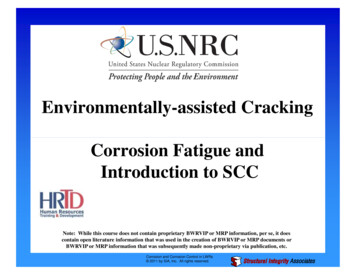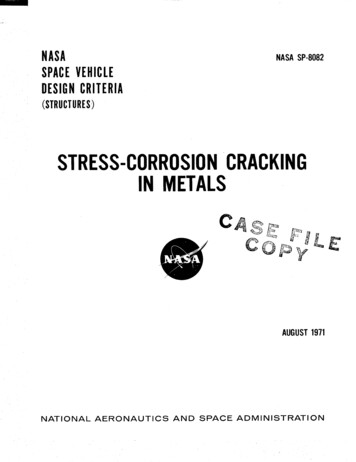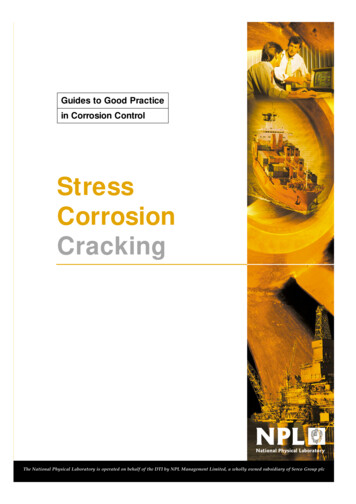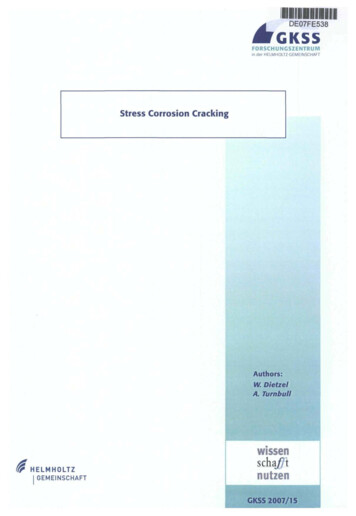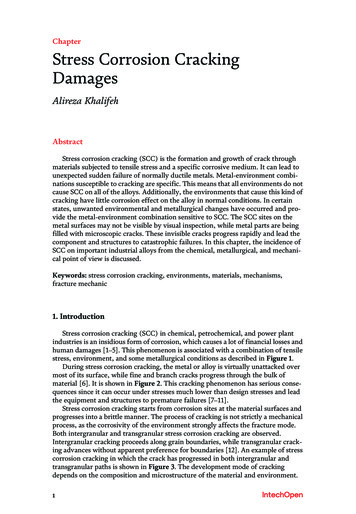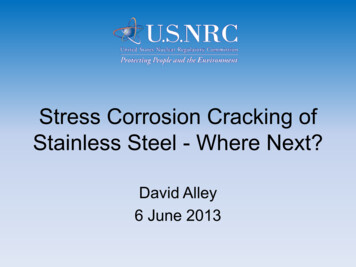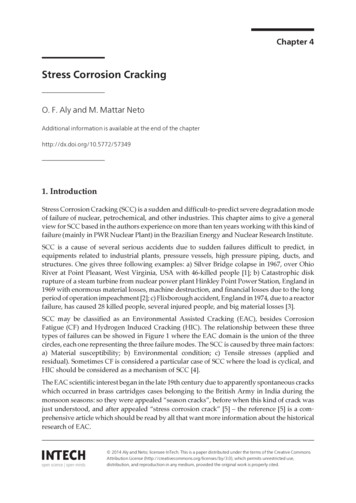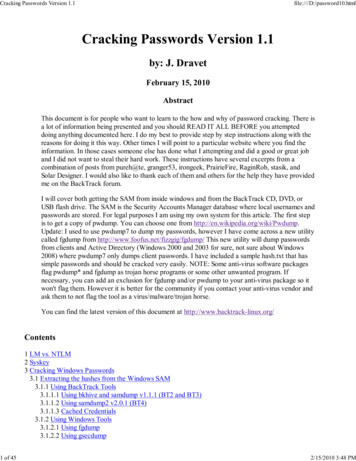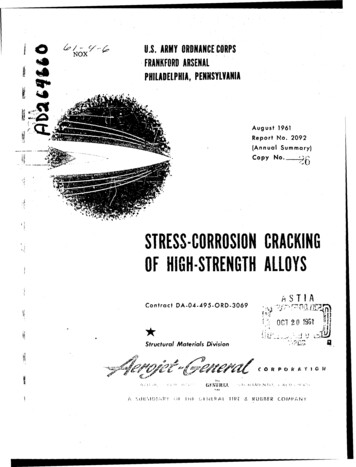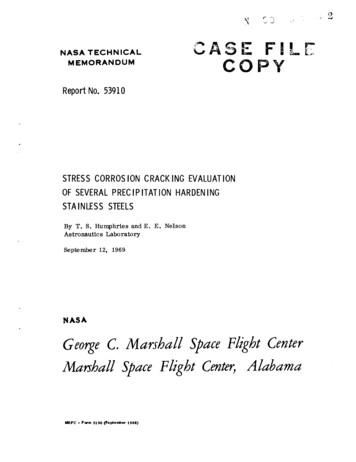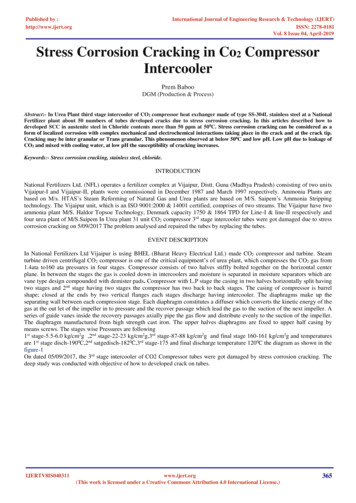
Transcription
February 2022, Vol. 22, No. 1DOI: 10.21062/mft.2022.012MANUFACTURING TECHNOLOGY 2022 Manufacturing Technology. All rights reserved.ISSN 1213–2489http://www.journalmt.comStress Corrosion Cracking and Copper Alloy ProductsVladivoj Očenášek (0000-0002-7817-8701), Jan Luštinec (0000-0001-8764-6514)SVÚM a. s., Tovární 2053, 250 88 Čelákovice. Czech Republic. E-mail: ocenasek@svum.cz, lustinec@svum.czStress corrosion cracking (SCC) is a common cause of structural failure. The simultaneous action of thecorrosive environment and tensile stresses creates cracks that have an intercrystalline or transcrystallinecharacter. These are cracks with a fragile morphology of the fracture surface without signs of plasticdeformation in their vicinity. SCC cracks occur in several alloys. This paper focuses on copper alloys inwhich this type of failure occurs frequently. Examples from practice show cases where the occurrence ofSCC violation was related to the conditions of use of components and their production technologies. Thepaper does not aim to capture all the influences associated with the occurrence of SCC failure of copperalloy products.Keywords: SCC stress corrosion cracking, Copper alloys, Cold deformation, Heat treatment, Tensile stress, Residual stressIntroductionStress corrosion cracking (SCC) is one of the formsof breaking materials. This type of failure often leadsto unexpected and sudden fractures. Cracks form andpropagate always occur in a corrosive environment inthe presence of tensile stresses. SCC violation is thusdue to the interaction of these two factors. Anothercharacteristic feature of SCC failure is imperceptiblemanifestations on the surface at the crack site. Thereare no corrosion products on the surface and no tracesof plastic deformation are visible around the crack.The absence of plastic deformation is due to the factthat cracks occur at stresses lower than the yieldstrength. SCC failure occurs at various combinationsof chemical composition of the material, the state ofthe structure of the material, the state of the surface,the composition of the ambient atmosphere, temperature, and mechanical stress. Due to the emergence ofSCC violations, different combinations of these factors lead to a relatively large variance of results and totheir difficult predictability. For a particular metal oralloy, there are then typical environments that causeSCC failure. Therefore, in the case of long-term exposure to stress and the environment, a change in thechemical composition of the environment over timemay also play a role. Because failure of a structure orpart due to SCC occurs at low stress levels, cracks canoccur over a wide period, depending on the interaction of the individual factors. It can be tens of hoursor many years. SCC fractures have a brittle fracturemorphology and can be intercrystalline or transcrystalline. In many cases, these are mixed quarries, whichhave both transcrystalline and intercrystalline character (Fig. 1). Often the crack branches away from themain crack. The formation and propagation of SCCindexed on: http://www.scopus.comcracks can be influenced by other factors related to theproduction technology and the type of alloy. Theseare, for example, phase changes, the occurrence of intermetallic phases or precipitation processes.Fig. 1 Partly intergranular and transgranular SCC crack oftwo-phase (α/β) brass CuZn40Pb2 [10]The place of occurrence of SCC cracks is usuallysurface defects from machining, handling, local corrosion attack, inclusions, dealloying, structural notchesor it can be fatigue cracks. The severity of thesesources of SCC cracks is then determined by the magnitude of the stress (inserted or residual) and thenotching effect of the initial defect or structural notch.The occurrence of SCC cracks can be found both insteels [1, 2] and in alloys of non-ferrous metals [3, 4,5]. SCC violation cannot be completely ruled out forpure metals, such as pure copper or pure iron [6]. Copper alloys are a frequent subject of interest [7, 8]. Themechanism of formation and propagation of SCCcracks depends on both the environment and thecomposition of the material. Several models have been39
February 2022, Vol. 22, No. 1MANUFACTURING TECHNOLOGYproposed for SCC failure of metallic materials thatbind to pure metals or alloys of non-ferrous metalsand steels. The best known are models based on dissolution, adsorption and hydrogen embrittlement.The most frequently mentioned mechanism for anumber of metallic materials is the film-induced cleavage mechanism, in which a brittle nanolayer is formedaround the crack root. Detailed information on thesemodels is given, for example, in [6, 7, 9].This paper is devoted to the occurrence of SCCcracks in copper alloys. SCC failure is most often encountered in brass with a higher Zn content. Typicalexamples are machinable brasses, with a Zn contentof about 40%. Brass with a Zn content lower than15% practically does not suffer from SCC failure.Copper alloys in which we encounter SCC failure alsoinclude brasses containing Ni or aluminum bronze. Ifwe do not consider pure copper, then the least sensitive alloys are Cu-Ni binary alloys.The aim of the paper is to show the influence ofstress, production technology and the conditions ofuse on SCC cracking of selected products. The examples do not specify a corrosive environment. It wasalways a normal atmosphere of the outdoor environment or the environment during storage or production of the part. For this reason, possible mechanismsof SCC crack formation and propagation are not discussed. The conclusions proving that these are SCCcracks were made on the basis of information on theproduction technology, mechanical stress of the part,the results of metallographic analysis, hardness measurements and the characteristics of SCC cracks.ISSN 1213–24892.1 Cold deformationDepending on the stress level (whether residual orapplied), the corrosive environment determines theformation of SCC cracks. The first mentions of SSCin copper alloys are from the second half of the nineteenth century, when under the influence of a specificexternal environment, the ammunition deteriorated bycracking the cartridge case (Fig. 2). This form of SCCviolation was called season cracking. The name comesfrom the end of the 19th century, when ammunitionwas stored in stables during the monsoon rains in India until the dry season. Due to the internal stresses inthe cartridge case (after cold deformation in the manufacture of the cartridge case and superposition withthe stress introduced into the cartridge case by inserting the cartridge) and ammonia from horse urine,most cartridges corroded and cracked. Annealing toremove internal stresses in the manufacture of cartridges has eliminated this problem. Similarly, in thecase of cold-drawn bars, cracks can occur when storedin an unsuitable environment. Fig. 3 shows a case of acold drawn rod made of nickel brass CuZnNi18 storednear a sanitary facility [10]. In the case where the influence of the corrosive environment can be expectedand where there are residual tensile stresses on the surface in the product, and it is also possible to considerthe applied or operating stress, annealing must be usedto remove internal stresses. The annealing temperature for the removal of residual stresses in copper alloys is around 300 C.Sources of stressThe prevention of the formation of SCC cracksconsists mainly in the choice of a suitable material forthe given environment and in the choice of technological parameters of production, especially heat treatment and cold deformation. An important role isplayed not only by the tension in which the parts areused, but also by the history that precedes the use ofthe part. Stresses can be residual from production orintroduced by assembly or operating loads. Underestimation of the influence of the interaction of production technology (residual stresses), operating conditions (applied stresses), design influences and corrosive environment can lead to unexpected operationalfailures of individual parts or loss of function of theentire structure. Therefore, most cases of SCC violation are always a combination of the influence of anumber of factors. The unexpectedness of the occurrence of SCC cracks usually lies in the fact that theapplied stresses are much lower than those corresponding to the minimum values determined by staticstrength calculations.40Fig. 2 Season cracking of the brass cartridge casing [11]Fig. 3 SCC cracks of cold drawn CuZn20Ni18 bar due toimproper storage [10]The occurrence of SCC cracks due to residualstresses after cold deformation may also be related toancillary technological operations, such as the divisionof bars or thick-walled pipes. If they are separated after hot extrusion until the material has cooled, localsurface plastic deformation may occur at the cut surface, which may be a source of problems by followingcold drawing. When calibrating the dimensions of barsby cold drawing, for larger cross-sections, pushing theindexed on: http://www.scopus.com
February 2022, Vol. 22, No. 1MANUFACTURING TECHNOLOGYbar into the die is used. When pushing, the beginningof the rod at the exit of the die is stressed by tensilestress. If a sufficiently long time elapses between thedivision of the bars and the pushing into the die, aSCC crack will form at the face of the bar and the barwill rupture at the exit of the die (Fig. 4). The courseof the deformation of the surface layer caused by thedivision of the rod and the SCC crack adapted to theshape and orientation are very clearly visible in Fig. 5.These cracks, when pushed into the die, are the site ofextensive and fatal failure of the rod by longitudinalcracks (Fig. 4). On the fracture surface (Figs. 6 to 9),the initiating part of the SCC crack and the crack,which is formed only when pushed into the die, is thenvery clearly visible. This example shows that a completely marginal technological operation can lead toproduction interruptions, but the detection of thecause is not easy and instant? [10].ISSN 1213–2489Fig. 6 SCC initial cracks at the surface of the cut crosssection [10]Fig. 7 Overall view of the crack, which consists of the brittlepart of the SCC fracture at the surface and the continuing ductile fracture [10]Fig. 4 Fatal cracks after pushing the brass tube before drawing initiated by small SCC cracks [10]Fig. 5 SCC crack in the deforrmad surface layer after cutingthe rod [10]indexed on: http://www.scopus.comFig. 8 SCC brittle part of the crack [10]41
February 2022, Vol. 22, No. 1MANUFACTURING TECHNOLOGYISSN 1213–2489Fig. 11 Position of the SCC crack in the T-profile after heattreatment.and machining with marked position for crackmetallography [10]Fig. 9 Ductile part of the crack related to the SCC initialcrack [10]2.2 Heat treatmentAs opposed to the aluminum alloys, the occurrenceof SCC cracks in copper alloys due to heat treatmentof precipitation hardenable alloys is a relatively rarephenomenon. The cause is residual stresses that ariseduring cooling from the solution annealing temperature. Unlike tensile residual stresses after cold drawing,the residual stresses on the surface after rapid coolingare compressive. Compressive stresses are not dangerous from the point of view of SCC failure. However,under certain circumstances, an SCC violation may occur. An example is a low-alloyed age hardenable CuCrZr alloy. In Fig. 10 is a hot extruded T-profile,which has been machined to its final shape before soldering the contacts after heat treatment. After sometime after machining and soldering the contacts, acrack appeared on the surface on both sides along thewhole part (Fig. 11). It was an intercrystalline networkof SCC cracks (Fig. 12). After cooling from the solution annealing temperature, compressive stresses remained in the profile on the surface. However, due tothe removal of the material, part of the profile was redistributed so that there were tensile stresses on thesurface, which was the cause of SCC cracks. To prevent the formation of SCC cracks, it is necessary tochoose the procedure during heat treatment so thatresidual stresses are removed or minimized [10].Fig. 10 T-profile from CuCrZr alloy before heat treatmentand machining [10]42Fig. 12 Intercrystalline SCC crack in the T-profile after heattreatment and machining (Fig. 10) [10]2.3 Assembly and operational stressA typical and very common case of SCC cracks arefittings made of hexagonal bars from machinablebrass with a higher Zn content (CuZn40Pb2). Thebars are cold drawn to the required dimensional tolerances after hot extrusion. After cold drawing, tensilestresses remain on the surface. During machining,they are usually redistributed. In combination with thestress applied to the fitting during assembly, SCCcracks then form, usually in the thin threaded part ofthe fitting (Fig. 13 and 14). The applied stresses duringassembly can be caused by excessive tightening or bya larger volume of sealing material in the thread. Theeffect of the deformation during the cold calibrationdrawing on the uneven hardness along the cross section of the hexagonal rod is evident in Fig. 15. Thisfigure shows how the course of hardness changes dueto drawing and heat treatment. The preventive measure against the occurrence of SCC cracks is annealingto remove the internal stresses of the cold-drawn rodsand to observe the specified conditions during the assembly of the fitting.indexed on: http://www.scopus.com
February 2022, Vol. 22, No. 1MANUFACTURING TECHNOLOGYISSN 1213–2489SCC crack was caused by the notch effect in thegroove of the clamp for fixing the overhead line. (Fig.16). In the case of the static strength test of the clamp,the fracture occurs at the same location of the clamp,but with large plastic deformations at the fracture location (Fig. 17). The absence of plastic deformationaround the crack thus confirmed that it is an SCC failure [10]. To avoid the formation of SCC cracks in operating conditions, it is therefore necessary to optimizethe assembly forces.Fig. 13 SCC cracks of CuZn40Pb2 fittings due residual, assembly, and operating stresses [10]Fig 16 Due to assembly and operating stresses visible SCCcrack in the groove of the CuZn40Pb2 clamp [10]Fig. 14 Intergranular SCC crack in the brass fitting [10]180170CuZn40Pb2Colddrawn160HV3[1]150OK24Fig. 17 Crack of the CuZn40Pb2 clamp after static loading280 C/12 h140[10]130Conclusion500 C/1 h12011010090800,00Hot extruded0,200,400,600,801,001,20Relative distance from the edgeFig. 15 Influence of cold drawing and heat treatment on hardness of 24 mm brass hexagon bar (CuZn40Pb2 alloy) [10]Another case of the formation of SCC cracks,which were caused by the stresses applied during assembly, are brass clamps made of CuZn40Pb2 alloy.Clamps were used for fastening tram overhead contactline. As the clamps were not tightened with a torquewrench during the assembly, they gradually began tocrack under the assembly and operating stresses. Theindexed on: http://www.scopus.comThe examples of SCC cracks of copper alloy components in the paper characterize typical and atypicalcases of cracking, which lead to their fatal failure. Toprevent this type of failure, it is necessary not only tochoose a suitable type of alloy for the given corrosiveenvironment but also to consider both the influenceof production technology and assembly conditions.AcknowledgementThe paper presents the results that were achievedwithin the projects FA - EV 064/98 "Increasingthe utility properties of non-ferrous metal products and their alloys", FI-IM2/098 "Research oftechnology straightening and drawing of cooperalloys bars with enhanced shape and size accuracy” and FI-IM3/072“. Development of manufacturing technology of Cu-Ni condenser tubes43
February 2022, Vol. 22, No. 1MANUFACTURING TECHNOLOGYfor the power industry and rods from special copper alloys for automotive and mechanical engineering applications”.ReferencesMOHTADI-BONAB, M.A. (2019). Effects ofDifferent Parameters on Initiation and Propagation of Stress Corrosion Cracks in PipelineSteels: A Review. In: Metals, Vol. 9, No. 5. ISSN2075-4701.ZATKALÍKOVÁ, V., MARKOVIČOVÁ, L.,CHALUPOVÁ, M. (2016). Corrosion resistance of Cr-Ni-Mo Stainless Steel in Chlorideand Fluoride Containing Environment. In: Manufacturing Technology, Vol. 16, No. 5, pp. 11931198.ARSENAULT, B., SIMARD, S., MARCOUX,P., GHALI, E. (2006). Stress Corrosion Cracking Mitigation of 7075-T6 Aluminum Alloy byThermal Spray Coating. In. Paper presented atthe CORROSION 2006, San Diego, California.CARTNER, J. L., HAGGARD, W. O., ONG,J. L., BUMGARDNER, J. D. (2008). Stresscorrosion cracking of an aluminum alloy usedin external fixation devices. In: Journal of biomedical materials research. Part B, Applied biomaterials, Vol. 86, No. 2, pp. 430–437.44ISSN 1213–2489LUŠTINEC, J., OČENÁŠEK, V. (2019). Residual Stresses and Cracks in Forgings of Heattreatable Aluminium Alloys. In: ManufacturingTechnology, Vol. 19, No. 4, pp. 637-643.RAJA, V. S., SHOJI, T. (2011). Stress corrosioncracking: Theory and practice, Woodhead Publishing Limited, UK. ISBN 978-1-84569-6733.HALL, I. D. (1977). Stress - corrosion cracking ofcopper - base alloys. Thesis for the degree of doctor of philosophy, The University of NewSouth Wales School of metallurgy.KANNAN, B. M., SHUKLA, P.K. (2011).Stress corrosion cracking (SCC) of copper andcopper-based alloys. In: Stress corrosion cracking:Theory and practice, pp. 409 – 426. Woodhead Publishing Limited, UK. ISBN 978-1-84569-6733.JONES, R. H., RICKER, R. E. (1992). StressCorrosion Cracking Materials Performance NÁŠEK, V., LUŠTINEC, J. rs.org/t/ammo-deterioration/40790/6indexed on: http://www.scopus.com
Stress Corrosion Cracking and Copper Alloy Products Vladivoj Očenášek (0000-0002-7817-8701), Jan Luštinec (0000-0001-8764-6514) SVÚM a. s., Tovární 2053, 250 88 Čelákovice. Czech Republic. E-mail: ocenasek@svum.cz, lustinec@svum.cz Stress corrosion cracking (SCC) is a common cause of structural failure. The simultaneous action of the
